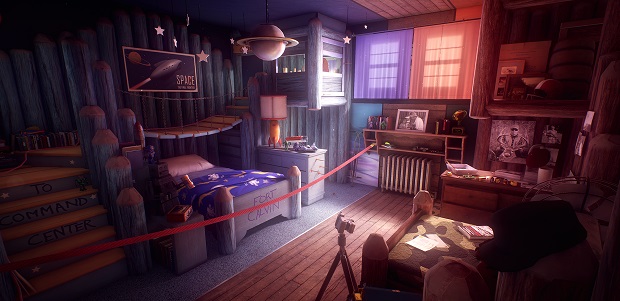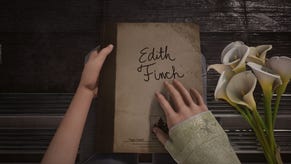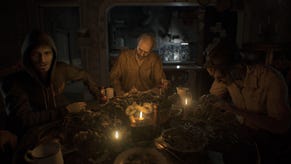Wot I Think: What Remains Of Edith Finch
Magical magical realism
Whatever the screenshot above might have made you think, What Remains of Edith Finch [official site] doesn't have very much in common with Dear Esther at all. It has a great deal in common with a lot of games I've played, but in the end doesn't feel very much like any of them. It's a walking simulator for about ten minutes, and then it becomes all manner of other things, including one of my favourite games in years. Here’s wot I think about this extraordinary family saga.
Walking simulators come in many flavours and have tackled many genres of narrative in recent times. There’s the sincerity of Gone Home, in its single location that contains enough experiences for a lifetime, the quaint sci-fi radio drama of Everybody’s Gone to the Rapture in its none-more-British period setting, and the romantic mysteries and serenely grand natural environments of Firewatch. I like all three of those games, to varying extents, but I’ve always thought the kind of interactive storytelling their developers are exploring is in its nascent stages.
Though both Rapture and Gone Home have their own ways of presenting the process, they lean on the audiolog tradition of story discovery. You go to a place, you hear narration, you move on. Firewatch is more open, in terms of using dialogues rather than monologues, and though their worlds are of varying sizes, they all give some room for exploration outside the linear tracks of their stories. They are games about looking, listening and learning, though much of my enjoyment of them comes from simply existing in these places, both familiar and strange. Virginia, which I liked far more than anyone else around me did, had an interesting approach, taking some of that ability to control and exist away from the player, and instead propelling them through confusion and smash cuts.
I always want more though and in What Remains of Edith Finch, Giant Sparrow have delivered so much more than I imagined a single game would. Like Gone Home, this is the story of a young woman returning to a family home, and like Everybody’s Gone to the Rapture, it’s a story made up of several voices, telling the tale of an entire community. In this case, that community is the Finch family and their house, which is a towering, jumbled structure and a monument to all that they have lost. It is so large, rooms stacked on top of one another to form a tower at one corner, because no bedroom has ever been recycled. When its owner passes on, the room is kept as it was, sealed so that it is part museum and part mausoleum.
Over the three generations the Finches have lived in America, having moved from Norway in the early twentieth century, many rooms have been constructed. And that’s because Finches have a habit of dying young. They’re either cursed, unfortunate or too adventurous/unhappy/restless/fragile to exist in the real world. Throughout the game, you, as the last surviving member of the family, Edith, explore the house and learn about the fate of your siblings, parents, grandparents and others. At the end of every story, somebody dies. In a way, you die because you always control the character on the chopping block.
The framing story of the doomed family could be tragic, darkly comic or terrifying. The beauty of the game is that it doesn’t settle on one genre, instead presenting the Finch family as an anthology of tales, each told in their own style. A child star’s life comes to a grisly end in an EC Comics Horror story, with a Cryptkeeper-like narrator who relishes every telegraphed twist and delicious irony. Elsewhere, an imaginary world distracts from dull days at work, eventually drowning out the daily grind entirely. Or almost.
All of these stories are controlled, from a first-person perspective that Giant Sparrow repeatedly find new ways to recontextualise. If there are no other lessons for interactive storytellers to take from Edith Finch, the flexibility of its perspective is vital. This is the camera as identity and as an engine for empathy. It’s also a superb technical feat. In what will most likely become the game’s signature sequence, you’ll take a tour of the animal kingdom, through their own eyes, in ten of the most astounding and exhilarating minutes I’ve ever experienced in a game.
Edith Finch doesn’t just do magical realism beautifully, it makes me think games, rather than literature or film, are the genre’s most natural home. There’s a sequence that reminded me of the most extraordinary conceit in Gabriel García Márquez’ The Autumn of the Patriarch and Matthew Arnold’s Dover Beach simultaneously, and I wasn’t just amazed that two of my favourite things were being alluded to (consciously or not), but that Edith Finch sat so comfortably in their company. Its stories are more for the heart than the head but even when it’s riffing on cheesy genre fiction, this is a smart game.
It’s a sentimental game too. There's no meta-humour or ironic detachment, as you'd find in the likes of The Stanley Parable. This is hearts-on-sleeves time and if you’re not as much of a softie as I admittedly am, you’re probably not going to adore it quite as much as I do. There’s one story in particular that had me in bits, needing a supportive hug and a cup of tea before I was ready to carry on, but I’d understand if some people were left cold by it, or even found it exploitative. Heart strings are tugged, unapologetically, and emotions are manipulated. That’s what stories and art do though. We only tend to complain when we’re not convinced a story has earned the reaction it aims for, or if the machinery that’s pulling and prodding at us is too obvious.
For me, Edith Finch earned every tear, every laugh and every moment of joy. It’s two hours, maybe just a little over, with no padding whatsoever. In those two hours you’ll see and do more than most games will ask of you in twenty. Giant Sparrow’s previous game, The Unfinished Swan, is referenced as another story within the matryoshka of stories that is the game as a whole. This is a much more confident game, using control and perspective to the benefit of its story without ever requiring the player to do busywork or achieve goals that aren’t directly related to the tale. The individual sections here don’t feel like minigames, as in That Dragon, Cancer, but like natural extensions of the characters and words.
In the end, the bitter/sweet end, Edith Finch is a game about storytelling. It’s not just about the different stories that people tell, to figure out their place in the world or to try and reshape that place, but about the forms those stories can take. Comic books, weird tales, romance, sentimental drama, tragedy, escapist fantasy, games, daydreams, a photograph, a conversation, a memory, a painting, a poem.
Here’s a launch trailer, but if you’re already planning to buy the game, I’d skip it so that every single image comes as a surprise. I’ve picked the screenshots carefully, for similar reasons, but what I can’t get across with words is how important the soundtrack is. It’s wonderful, both in its own themes and the music that it uses from elsewhere.
What elevates it from a fascinating and gorgeous experiment in presentation to an immediate contender for my game of the year is the way that the broader narrative informs the stories it contains, just as the house is home to its many rooms. Without casting judgement or becoming didactic, Edith Finch explores both the good and the harm that stories can do, and how folktale, imagination and superstition can lift us up and dash us down.
It does all of that with such inventiveness and such a powerful sense of joy that despite spending time fighting back tears (and failing to do so), I was elated from the first out of body experience to the end of the credits.
What Remains of Edith Finch is out tomorrow, for Windows. It will be available on Steam for $19.99.




















